Fun Things to Do with Pug Dog

10 Super Fun Things to Do with a Pug
Overview
Maybe its seems like your Pug is getting a bit bored, or maybe you just want to do something new and interesting with your puppy or dog. Either way, this section will cover 10 fun things to do with your Pug that will be a blast for both of you.
Some of these are perfect if you want to stay at home and others are ideal if you want to get out and about with your Pug.
A great benefit to doing activities with your Pug is that it strengthens the owner/dog bond. And, some of these ideas have additional benefits like building a Pug’s self-confidence and providing mind exercises which are thought to increase well-being and help prevent canine cognitive dysfunction, a common issue seen with senior dogs.
Let’s see what sort of fun things you can start doing with your Pug today.
#1: Teach your Pug to understand more words.
Did you know that the average adult dog can understand approximately 165 words or short phrases? It’s true. But, even more amazing is that canines are capable of knowing many more. A Border Collie named Chaser knew more than 1000 words!
So, if you think that all your Pug will ever understand is a few commands and perhaps the word ‘dinner’, your Pug can greatly exceed your expectations, with your help. And, it’s a lot of fun when your Pug understands more of what you say.
Just by speaking the name of objects, your Pug will catch onto some words. But, to speed up learning, have several teaching sessions per day. The only things you will need for this are the objects that you want your Pug to know by name and some training treats.
Be sure that the treats are small (so they don’t interfere with appetite), something that is not normally given out (so they are seen as special), and chewy (these work better than dry to send out the message of a job well done). A good example of effective training treats is Fruitables Skinny Minis Soft Treats . Since Pugs are prone to weight gain, this is a great low-calorie option. And, these are super-tasty; there is watermelon, chicken, pumpkin & mango, grilled bison, and apple & bacon, all which have only 2 to 3.5 calories per treat.
. Since Pugs are prone to weight gain, this is a great low-calorie option. And, these are super-tasty; there is watermelon, chicken, pumpkin & mango, grilled bison, and apple & bacon, all which have only 2 to 3.5 calories per treat.
For these fun teaching sessions, set out 3 objects onto the floor. Pick up each one, clearly enunciating the word for it. Then, ask your Pug to get one that you call out. When your Pug is right, offer praise while including the word (example, ‘Good boy, leash!’ or ‘Good girl, remote!’) and then palming a reward treat.
Once your Pug has learned that set of 3, move on to new ones; but, periodically go back to any items previously taught so that your Pug doesn’t forget.
#2: Teach your Pug some helpful commands or fun tricks.
This is a great way to increase the bond you have with your Pug while offering your canine family member the gift of self-confidence.
If you’re just starting out, first go over the basic commands that all dogs should know: Sit, stay, come, heel, and down.
And, if your Pug has those down pat, you can both have tons of fun by moving onto tricks. Pugs can learn all sorts of things including roll over, play dead, dancing, praying, hoops, and much more.
A great book for this is 101 Dog Tricks: Step by Step Activities , which has easy-to-follow instructions with helpful color photos of each step for both commands and tricks.
, which has easy-to-follow instructions with helpful color photos of each step for both commands and tricks.
Cuteness break!
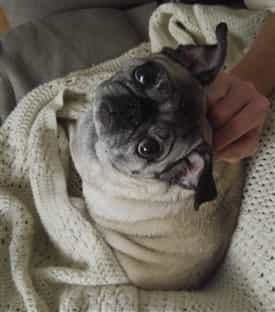
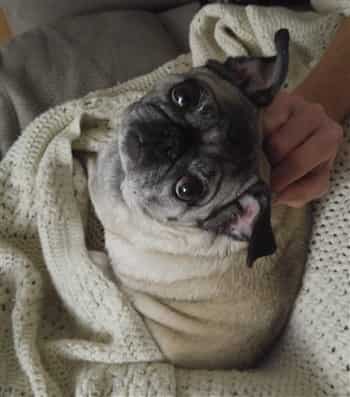
Wonton, at 8 and 1/2 years old, photo courtesy of Megan Voisard
#3: Play hide n’ seek.
This is a great way to have fun with your Pug inside the home, and particularly on a rainy day when you want to prevent boredom for the both of you.
There are several ways to have your Pug stay still while you jot over to a hiding spot:
- You can order a ‘sit’ (if your Pug obeys this command).
- Have a helper hold them.
- Or set up a gate or similar object across a doorway, leaving a small opening, then distract your Pug by tossing an item of interest toward the back end of the room. Your Pug may catch on to this method of distraction rather quickly and that's okay, many dogs will voluntarily be 'distracted' so that their human can hide.
Here are some tips to keep this fun:
1) Always plan your hiding spot so that your dog doesn't catch you standing in a room while you wonder where to stash yourself.
2) Have treats in your hand or pocket, so that you can reward your Pug as soon as he finds you.
3) The first time you hide, choose an easy spot in the next room over. Behind a sofa or behind a door is a good choice.
4) When you're ready for your Pug to begin searching, call out their name one time, in a soft yet eager 'come and find me!' tone.
5) As soon you are found, offer a treat and lots of praise.
6) For as long as you want to play with your Pug, reset the game by placing your Pug in the 'starting area’.
7) Each time you hide, choose a slightly more difficult spot. By the 5th or 6th time, you should be a couple of rooms away, completely out of view. Some good places? The bathtub with the curtain drawn, a closet with the door slightly open, or underneath blankets.
8) A session of about 10 'finds' is usually ideal because you want to end when your Pug is feeling good and hasn't become tired of it. This leads to wanting to play the next day.
#4: Play a puzzle game together.
Puzzle games are a fantastic way to have fun with your Pug. And, studies suggest that this sort of activity, that puts a dog’s mind to work, is helpful in a number of ways including better overall health and decreased chance of canine cognitive dysfunction later in life (the canine equivalent of Alzheimer’s disease).
There are many types of puzzle games for dogs. For example, the Trixie Flip Board
 is a flat floor-based puzzle where you hide treats behind compartments and teach your Pug how to nose or paw the various covers, flippers, sliders, and knobs.
is a flat floor-based puzzle where you hide treats behind compartments and teach your Pug how to nose or paw the various covers, flippers, sliders, and knobs.
And, the Trixie Gambling Tower
 is a see-through tower on a sturdy base that holds treats that are released when your Pug learns to tug on the connector ropes.
is a see-through tower on a sturdy base that holds treats that are released when your Pug learns to tug on the connector ropes.
With these types of fun games, just remember that your Pug is not meant to play alone. It will be your job to show your Pug what to do and offer happy words to encourage them to keep trying or praise when they eventually catch on.
Cuteness break!
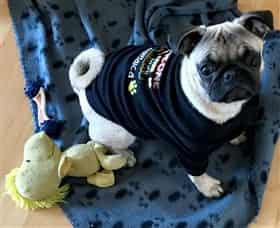
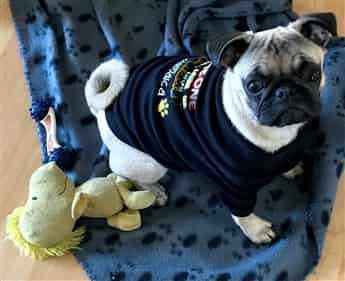
Penny, at 5 months old, photo courtesy of Jamie
#5: Have fun with bubbles.
Many dogs find it thrilling to chase after bubbles and it can be a great way to get your Pug moving and meeting exercise requirements.
If you manually blow bubbles for your Pug, this can be done either indoors or outdoors. And, if you want to play outside, and particularly if you want to be able to sit back and enjoy watching your Pug give chase and romp around without having to blow the bubbles yourself, consider setting up a children’s bubble machine.
One like the Geekper Automatic Bubble Blower
 sends out hundreds of bubbles each minute, you can plug it in or have it run on batteries, and you can experiment with how far or close you place it to see which distance gets your Pug moving along.
sends out hundreds of bubbles each minute, you can plug it in or have it run on batteries, and you can experiment with how far or close you place it to see which distance gets your Pug moving along.
#6: Visit a farm or orchard.
Depending on the season, it can be a great time to go strawberry picking, apple picking or even explore a pumpkin patch. Often, apple orchards also have peach trees and other fruit trees to fill in between apple season. It can be a great way to do something new with your Pug and afterward (or during), you can sample the fruit. Strawberries are safe for dogs to eat. Peach and apple can be given to dogs if you cut out pieces (only the core, seeds and pits are toxic).
Cuteness break!

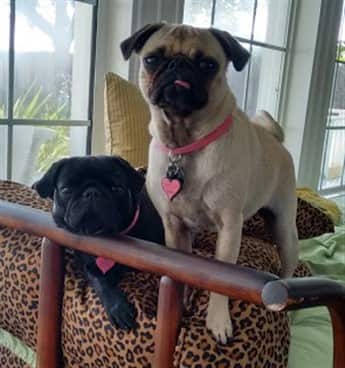
Ellie ( Black) at 1 year and 9 months and Nana Jr (Fawn) at 1 year and 8 months,
photo courtesy of The Piccardo and Moreno Family
#7: Play fetch with a new toy.
Some dogs will chase after anything that is thrown; but, others need a bit more incentive. If you want to get your Pug to really enjoy a game of fetch, it helps to do this with something novel and exciting.
One option is fetch balls that have interesting elements like the LED Wacky Squeaky Balls . This is a set of 3; All have flashing lights and make silly noises. Each has a different texture, soft rubber, hard rubber, and soft nubs (which makes it easy to mouth).
. This is a set of 3; All have flashing lights and make silly noises. Each has a different texture, soft rubber, hard rubber, and soft nubs (which makes it easy to mouth).
And, another terrific option is a Chuckit! Flying Squirrel Toy . These are perfect for Pugs, since they are designed for short-range flight and they spin in the air which helps trigger a chase response.
. These are perfect for Pugs, since they are designed for short-range flight and they spin in the air which helps trigger a chase response.
With fetch, keep in mind that your level of enthusiasm plays a big role. Be involved and alert, and speak in an animated, happy tone. Just remember that fetch toys are designed specifically for throwing and retrieving and typically are not sturdy enough to be chew toys; so, reserve this just for when you are playing fetch with your Pug. An added bonus is that if the toy is hidden away until it’s time to play, this typically makes a dog more eager and interested.
#8: Treat your Pug to a meal at a dog-friendly restaurant.
There are lots of restaurants that allow dogs, either inside the eating establishment or outdoors on a patio.
Some places even have menu items specifically for dogs. For example, Starbucks has a ‘secret’ menu item called a Puppuccino; It’s an espresso-shot-sized paper cup full of whip cream (most dogs can tolerate dairy when given in moderate amounts).
At places that serve hamburgers, you can order your dog a plain hamburger patty without the salt; In n’ Out has one specifically for dogs called the ‘pup patty’ that even comes in its own doggy bag. At Tim Horton’s, you can order a sugar-free doggy version of their ‘Timbits’, which are bite-sized doughnuts. If you happen to live along the US east coast, you'll want to check out the Shake Shack; this place offers their own ShackBurger dog biscuits, a bag of 5 of them is called the Bag O’ Bones.
Cuteness break!
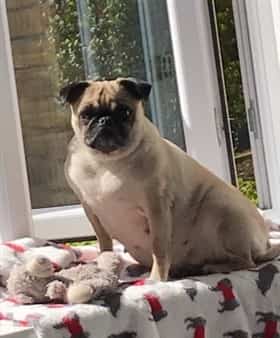
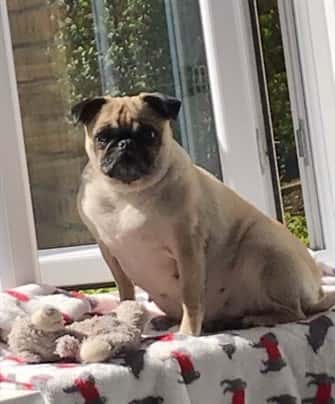
Dottie, at 3 and 1/2 years old, photo courtesy of Charlotte
#9: Take your Pug on a hike.
Pugs will be sedentary if allowed to be and it is true that overexertion is not a good thing for brachycephalic breeds. But, Pugs need daily exercise just like any other dog to manage weight, maintain muscle mass, and keep the heart strong.
Going on hikes can be a fun way to get your Pug moving, all you need to do is choose the right route and prep your Pug for safety.
When choosing a hiking route to take your Pug to, stick with trails designated as ‘easy’ or ‘beginner’. These will be short (usually 1 to 3 miles in total), have well-established trails mostly free of rocks, roots and other hazards, and have very little elevation gain.
To ensure that your Pug stays safe while having fun with you, there are a few things to prep in advance:
1) Protect your Pug’s paws with paw wax.
This is recommended year-round at any rate, but if you are not doing this already, it’s definitely something that should be done before taking your Pug on new terrain. A paw wax like Mushers Secret Paw Protection Wax
 will offer a breathable layer of protection.
will offer a breathable layer of protection.
Apply this at least 30 minutes before heading out and then every week going forward if you want to keep your Pug’s paws in good shape.
2) Bring along plenty of water.
You’ll want to take breaks every 15 to 20 minutes, and additionally if your Pug appears to need a rest. During those times, offer cool water. It’s important to be proactive about this since it’s much easier to prevent dehydration or heat stress than it is to treat it.
A travel water container like the PupFlask Portable Water Bottle
 is perfect when hiking with a dog. The container itself is stainless steel construction which makes it very durable. This has a neat design where a connected BPA-free section flips up and into a bowl. Any water that a dog doesn’t drink flows right back into the main bottle, so nothing is wasted or lost.
is perfect when hiking with a dog. The container itself is stainless steel construction which makes it very durable. This has a neat design where a connected BPA-free section flips up and into a bowl. Any water that a dog doesn’t drink flows right back into the main bottle, so nothing is wasted or lost.
3) Keep your Pug on a retractable leash and a safe harness.
As you may know, brachycephalic breeds like the Pug should never be on leash and collar. A collar around the neck, especially when connected to a leash, can severely impede breathing.
Harness are a much safer option. The neck is free and pressure from the leash is displaced over the shoulders, chest, and back. As added bonus, it is much easier to control and lead a dog when using a harness.
If you’re looking for one that is super-easy to place onto a Pug, the Puppia Soft B Harness Vest
 is a great option. You won’t have to place this over your Pug’s head at all; the front paws slip through and then there is a Velcro flap and an adjustable buckle on the back.
is a great option. You won’t have to place this over your Pug’s head at all; the front paws slip through and then there is a Velcro flap and an adjustable buckle on the back.
This is lined for comfort and also made of a breathable air-mesh which helps keep a dog cool. These start at size extra-small (for young pups) and go up from there. And, this is available in 13 different colors so that your Pug will always look stylish.
You'll want to pair the harness with a retractable leash so that you can let your Pug out and reel him in as needed without having to fumble with the cord.
4) Give yourself plenty of time.
If you and your Pug are just starting off with this fun activity, it can take some time to learn your Pug’s pace. Most hiking spots close at sunset, so you will want to leave plenty of time to ensure that you and your guy or gal are done with time to spare. It’s recommended to give yourself twice as long to complete the trail as you estimate.
Cuteness break!
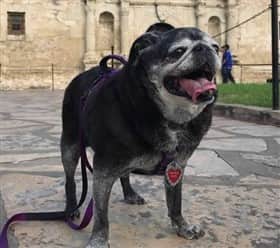
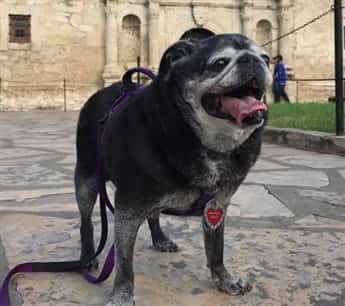
Miss Moo, at 12 years old, photo courtesy of Jerry, Shelly and Taylor Koltz
#10: Choose an activity to celebrate the season.
Have fun with your Pug by making the most out of whichever season it happens to be. In the summer, take your Pug to a dog-friendly beach to walk along the shoreline. In the spring, head out for a picnic. In autumn, rake up a pile of colorful leaves and jump into it together. In the winter, bundle up your Pug and play in the snow (for up to 20 minutes).
A Final Word
It’s easy to sit on a sofa with your Pug snuggled by your side and binge-watch a favorite show. And, while there is a time and place for that, don’t let it become the norm. Doing things together that require a bit of teamwork keeps owner/dog bonds strong and will moving around is good for your canine family member’s physical and emotional health.
You may also like:
Pugs with Itchy Skin
- The top leading causes of the frustrating problem, along with exact steps to resolve things.
My Pug Keeps Licking His Paws
- The top 6 reasons why a Pug will pay attention to the paws and exact steps to resolve this issue.
Top 10 Pug Eating Issues
- It's not uncommon for this breed to have some sort of eating problem; see the top 10 along with exact steps to resolve them.
Best Shampoos for Pugs
- What you use during the bath will have lasting effects on skin and coat health, how long your Pug smells good, and more.
Top Pug Dog Care Tips
- A roundup of the most important care tips for optimal health and comfort.
PetPugDog.com Copyright 2019. All rights reserved. Privacy Policy
We are a participant in the Amazon Services LLC Associates Program, an affiliate advertising program designed to provide a means for us to earn fees by linking to Amazon.com and affiliated sites.
